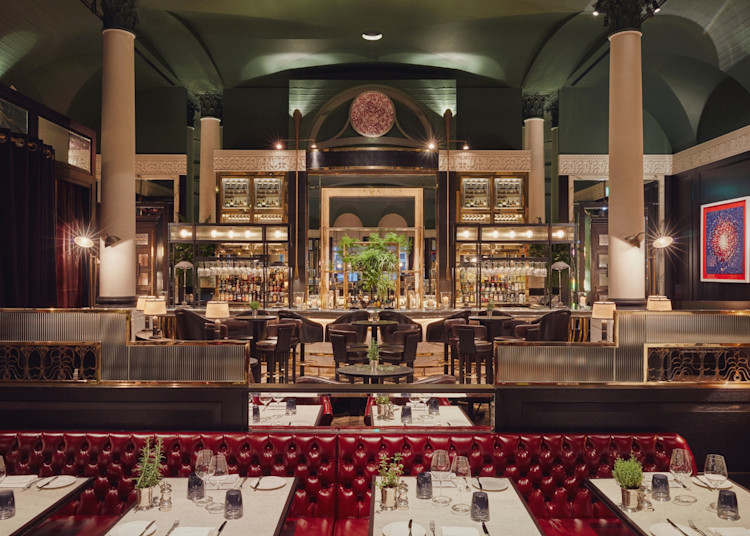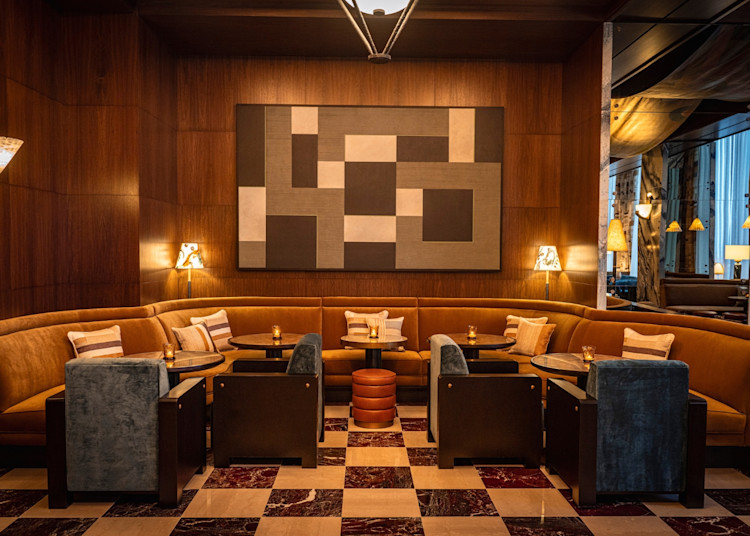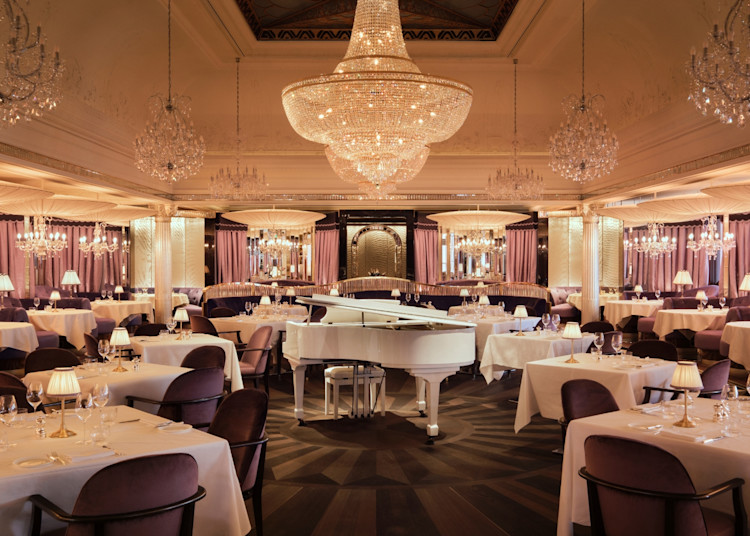London, 2003
The Wolseley
David Collins Studio collaborated with legendary restaurateurs Corbin & King to create a powerhouse quartet that transformed the London dining scene – with enduring commercial and cultural success.
When Corbin and King acquired the lease, they asked architect David Collins to complete its transition into The Wolseley Café and Restaurant. His sensitive treatment of the interior has engendered the sense of timelessness that has enabled The Wolseley to rapidly gain its iconic status for Londoners and visitors alike.
A.A.Gill, Breakfast at The Wolseley
The Wolseley's European brasserie formula, combined with the stardust applied by the founders, former Ivy proprietors Chris Corbin and Jeremy King, means that it is almost always full. It is open 18 hours a day, from 7am to 1am, seven days a week and is staffed 24 hours a day.
Jonathan Prynn, Evening Standard
If the past quarter century has been a golden age for the London restaurant scene, a single partnership soars above it like a mountain range. In a dazzling first act, Chris Corbin and Jeremy King revolutionised the capital’s dining culture in the 1980s and 90s with Le Caprice, the Ivy and J Sheekey – an iconic hat-trick with long-lasting potency. But it was their second act – as the newly-minted Corbin & King Ltd – that cemented London’s status as a global dining destination.
Between 2003 and 2013, Corbin & King launched the powerhouse quartet of the Wolseley, Brasserie Zédel, the Delaunay and Colbert – four restaurants that commercially transformed and socially electrified the capital’s restaurant landscape. And as they had with J Sheekey, Corbin & King turned to David Collins Studio to design this new family of restaurants.
The first of these, the Wolseley, made an immediate impact when it opened its doors in 2003, and it remains one of London’s most successful restaurants. None of this was a given when Corbin & King took over the lease of what, since 1921, had served as a Wolseley Motors car showroom, a branch of Barclays Bank, and a struggling Chinese restaurant. Yet Corbin & King had grasped the site’s potential as an all-day dining destination in the tradition of a grand European café – an untapped concept for London at the time.
David Collins Studio began the deceptively difficult task of delivering an aesthetically landmark restaurant with complex round-the-clock operations while working within the constraints of listed internal architecture. Creating its now-iconic monochromatic scheme, the studio transformed the space, layering contemporary London sophistication, Viennese grandeur and Florentine elegance, while maximising the impact of the building’s original vaulted ceilings with baronial hanging lights and gilded archways. Even the Barclays Bank-era marble counter was incorporated into the scheme, delineating what would become the restaurant’s famed bullring.
The result was a venue as welcoming as it was dramatic. The soaring lateral space delivered a visual punch that has never diminished, while carefully zoned lighting ensured pools of intimacy. Upon opening, the Wolseley was wildly successful – the favourite haunt of the great Times restaurant critic AA Gill, alongside Kate Moss, Elton John and many other luminaries. Within four years, it had become London’s first £10m-turnover restaurant, serving 1,200 people daily without compromising its mystique. And now, more than 20 years after its launch – and under a change of ownership to Minor International – its success remains undiminished.
Following the triumph of the Wolseley, David Collins Studio was tasked with designing Corbin & King’s next venture – the Delaunay, launched in 2011 on the corner of Drury Lane and Aldwych. Like its sister restaurant, the Delaunay was also inspired by the grand cafés of central Europe, though in contrast, it started life as an empty concrete shell – hard to believe when entering what is now a space so seemingly rich with heritage and pedigree. “The best compliment we receive is that people assume it has always been there,” says Iain Watson, CEO of David Collins Studio. “That is exactly what we set out to achieve.”
As with its sibling, the Delaunay delivers a thrill when entering its dramatic lateral space, yet it is structured and layered in such a way that it reveals itself gradually. It’s not always easy to discern what makes a good restaurant a great one – but in the Delaunay’s case, it’s the design details that continue to form a connection with its guests, from its famously flattering lighting and generous spacing between tables to the reassuring sense of permanence engendered by its geometric motifs and dark wood panelling.
The Delaunay was a hit upon launch and remains a thriving London institution. “Few restaurants are grander or more reassuring than the Delaunay,” says Tatler, describing it as “London’s beloved restaurant.”
Just a year later, in 2012, a new collaboration between David Collins Studio and Corbin & King opened its doors. Brasserie Zédel is an Art Deco wonder inhabiting the space of the totemic 1990s Atlantic Bar. Where the Wolseley is a sharply stylish monochrome and the Delauney a timelessly elegant wood and brass, Brasserie Zédel leans into Art Deco whimsey – a searingly pretty dining room of marble pillars, gilt cornicing and fabulous Deco lighting, accented by powder-pink tablecloths and side lamps.
While significant design changes included moving the entrance from the basement to street level, Watson describes the project as a delicate balance of restoration and reinvention: “While the main dining room had been restored by the Crown Estate, our role was to enhance the existing features while adding new elements like custom banquettes, lighting, and murals.” And as with its sisters, Brasserie Zédel is an ongoing commercial success. “It’s fast, punchy, and more accessible than the Wolseley or the Delaunay, but it still offers a high-service experience,” says Watson.
Later that year, Colbert opened on Sloane Square, on the site of the old Oriel Café, marking the final piece of this landmark quartet. When the site’s lease first became available, it ignited a frenzy of competition from almost all of London’s key restaurateurs – situated as it is on the iconic square in the heart of Chelsea. David Collins Studio played a pivotal role in winning the bid for Corbin & King, presenting a holistic vision that celebrated the building’s history while proposing a vibrant neighbourhood café – backed by the weight of the studio’s peerless track record of delivering aesthetically groundbreaking and commercially successful ventures.
“Colbert was about bringing café society to Chelsea,” says Watson. “We focused on the ground floor, creating a space that felt cohesive yet varied, with different zones for dining and drinking.” Where the Wolseley and the Delaunay are Viennese at heart, Colbert is Parisian – and its success was the catalyst that revitalised Sloane Square, transforming it into a thriving cultural and social hub. “It’s a testament to the power of good design to elevate a location,” says Watson.
The enduring success of this talismanic quartet of restaurants is a tribute to the harmony between Corbin & King’s vision and David Collins Studio’s design expertise. London is known for the giddy pace of new restaurant openings and the speed of its cyclical fashion – which makes it even more extraordinary that decades later, they remain such desirable and relevant venues. “It’s about creating spaces that are not only beautiful but also functional and durable,” says Watson. “Investing in quality materials and bespoke furniture ensures longevity, which is crucial for high-traffic environments.”
He adds: “These restaurants have become part of the fabric of London. They’re more than just places to eat; they’re cultural landmarks.”
Written by Peter Martin
Photography courtesy of The Wolseley Hospitality Group
Awards
Restaurant of the Decade
Taste of London
Square Meal Top 100
No. 5
Related projects
Kerridge's Bar & Grill, London
Hospitality
TAK Room by Thomas Keller, New York
Hospitality
Tre Dita, Chicago
Hospitality
The Georgian at Harrods, London
Hospitality











